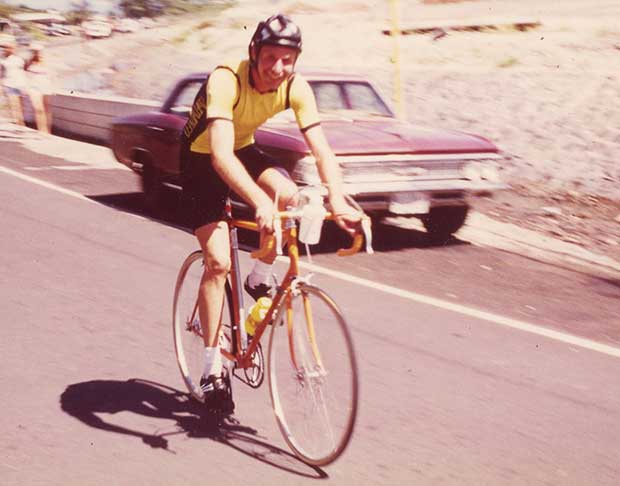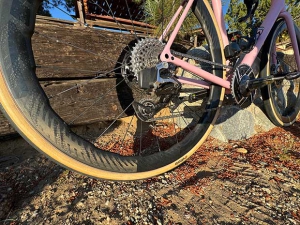
I’m writing about a major change in road bike positions today, but there is a message here about tri. In fact, you could say that tri positions when understood correctly offered glimpses into the changes we’re seeing in road bike position.
Hips moving forward in the saddle is the biggest positional change in road bike racing since the 1970s when I started riding. If you’re watching the Tour (ongoing as of this writing) look at how many of the racers who have their saddles pushed forward, maybe all the way forward, on the rails. What’s that about?
This is my explanation, based on both what I see and experiments with my own road position. You can decide yourself whether you believe hips – and saddles – are more forward now than they were, say, a half-dozen years ago. Also my opinion: Two equipment changes working in tandem have changed the way today’s best riders sit aboard their road bikes: the comfort of today’s hoods; and the achievable high cadences while climbing due to recently available lower gears.

Saddles have been edging forward for several years, I just think the dam broke in the last year or so. I suspect this will cause frame makers to rethink their seat post geometries. I think frame geometries are fine but the seat posts need a rethink, especially because so many road frames (regrettably) come with seat posts that can’t be changed. (The same thing happened with tri bike seat posts 10 or 15 years ago.)
Just to be clear I don’t think the entire cockpit is moving forward and let’s define terms. Cockpit in cycling has two meanings. Cockpit Position: the relationship between the saddle and the handlebars. Cockpit Hardware: the stem, handlebar, hoods. If you alter your cockpit position you might – for example – increase or decrease the distance from the saddle to the handlebars. A tight cockpit means you’re riding kind of scrunched and Pogacar is my best example of a tight cockpit.

While other riders might not be riding Pogacar tight in their cockpits I don’t believe handlebars are moving forward the same distance that saddles are moving forward. In fact, while saddles are coming forward a centimeter or two – or three – I don’t think handlebars are moving forward at all. I base this on how much of the hood the riders are grabbing as they’re riding. In particular on seated climbs. In my own case, my Web X measurement remains 600mm, which it has been for many years. To measure Web X, you note where the web of your hand meets the pommel of the hood. Web X is the “run” – the horizontal distance – between the BB and the midpoint between the pommels of each hood. I place a lace lock over my hoods, run a plumb line through the BB, and measure from that plumb forward to the centerline of the lace lock.

While I haven’t moved my handlebars anywhere I’ve moved the saddle closer to the bars. This is what I believe the pro peloton is doing. In my own case, the nose of my saddle has been routinely about 85mm or 90mm behind the BB and while saddle geometries have changed I’m riding the same saddles now that I rode 15 or 20 years ago. My saddles are now 65mm to 70mm behind the BB. This has moved my hips forward and tightened the cockpit. Note that my riding out of the saddle hasn’t changed because I haven’t moved my handlebars; the change is that my hips are less behind my cranks when I’m seated.
Moving the saddle forward may place more of your weight – more pressure – on your hands. This is fundamental to why saddles were further back for the last – oh – 100 years. If you haven’t ridden new SRAM RED (highest pic above), or current Dura Ace (pic just below that), you can’t appreciate how much more comfortable these controls are. Even SRAM RIVAL and Shimano 105 (the image just below) are really comfortable, and promise to become more so as hood shapes – and the handlebars to which they mate – get more comfortable. (See Zipp’s road bar that was made to mate specifically with new RED.) These new hoods mean that if there is a slight bit more weight on the hands (which is questionable) this does not discommode the rider.

Have you noticed how much more time the top riders spend on the hoods these days, even while seated climbing? Perhaps only oldsters like me notice this. Search Greg Lemond or Bernard Hinault “climbing” and hit the Images tab. You’ll see a lot of photos of riders with their hands on the “tops”. Hands on the hoods when seated on a climb were the exception in the 1970s and 80s. One reason was hood discomfort for sure, but another is that the cockpit position was too long back then. Saddles were rearward and hoods were further forward on the bars. Even with today’s hoods it would’ve been a big stretch – literally – to ride with hands that far in front of the rider’s trunk and torso.
Comfortable hoods allow you to ride more forward. But they aren’t the only (or the main) reason riders are pushing their saddles forward. When I entered the cycling scene in the late ‘70s the typical freewheel was a 5-speed made by Regina that began at 13 teeth and ended at 21 teeth. Chain rings were either 52t or 53t for the big ring and 42t or 39t for the small ring. Exceptionally, for really steep hills, you had a 13-23 available. The absolute lowest gear you could put on your race bike was a 39x23 (if you rode Campagnolo/Regina, which almost all of us did). But the roads and hills remained as steep then as they are today, as well as the power required to ride up them. Power equals torque x cadence and what you didn’t have back then was cadence riding those pitches with those gears. So, you made do with torque. That required leverage. You sat back in the saddle, hands on the tops, and mashed your way up hills too steep to spin up (or you rode out of the saddle). You don’t see anyone mashing in the pro peloton today.

I’ve got both a SRAM and a Shimano road bike in my garage and the Shimano (11-34 cassette above) has a 34x34 as the lowest gear. My race bike in 1980, on which I rode the 1981 Hawaiian IRONMAN in the pic highest above had a 42x21 as the lowest gear (you probably can't even see the cogs in that pic they were so small). Easy to figure out by looking at this that 34x34 can be called a 1:1 ratio while the smallest gear on my bike 45 years ago years ago was a 2:1 ratio. This lower gearing has been a revelation. It has completely changed the way I climb on my bike, because the gearing allows me to ride the cadence appropriate for the effort.
My SRAM bike has an even smaller gear: 33t ring and 36t small cog (SRAM’s 10-36 cassette below). Riders today spin up even the 24 percent grades they see in the Vuelta. Everything can be ridden at cadence.

What you’ve seen, if you think about it, is that cadence, effort and hips position all scale together. Think about this in the context of riding on the flats. The harder the effort the more you ride toward the nose of the saddle – “He’s riding on the rivet!” – and the faster your cadence. No leadout rider hauls his sprinter to the front of the peloton riding “on the rivet” at 70 beats a minute. That cadence is around 100 beats a minute but that same rider when riding easy may well sit back, sit a little higher up, and ride 75 or 80 beats a minute. The advent of lower gears allows riders to sit a bit forward on the saddle even during sustained climbs, hands on hoods, because that faster cadence is rideable even on steep pitches. Pogacar is the most obvious example and the harder he rides – even up steep pitches – his hips are forward, his cadence is quick, and his hands are draped over the pommels of his hoods. But look at the other riders; they’re riding more or less similarly.
In triathlon we have known for decades that as effort goes up cadence goes up and hips move forward. On our tri bikes our hips are way forward. We can do this because we rest the upper body on our bikes skeletally, laying our forearms on the aerobars. There’s only so far forward you can move on a road bike because we need to hold our upper bodies up muscularly. Not too much weight can come down on our hands. Lower gears mean we can ride steeper hills at cadence and that higher cadence is best ridden with hips further forward than they used to be. You stick your saddle there and that means you’re able to ride in the hoods without feeling stretched. The ergonomics of today’s hoods allows you to ride there 90 percent of the time.
And finally...! (And please pardon the aside.) What I've written above explains why I'm so dead-set against integrated cockpits (and by "cockpit" I'm talking now about the physical product: handlebars and stem smooshed together into one thing). I've been riding road bikes for a while (that bike you see in the pic highest above I got 45 years ago). I ride a sound, orthodox position. Bike fit has been a subject of interest for me for decades. Yet I still find bike position to be a moving target, with the emphasis on moving. You can't alter unalterable positions.



